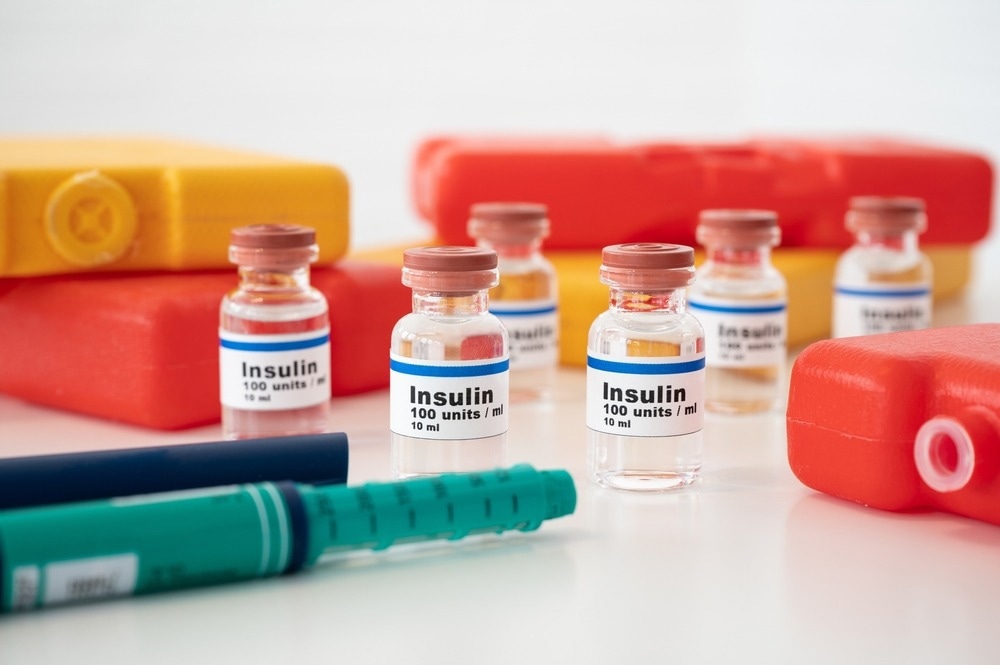Accurate insulin-delivery platforms responsive to blood glucose fluctuations are required to control hyperglycemia. Such platforms would also effectively prevent hypoglycemia diabetes. Recently, scientists from RMIT University, Monash University, the Baker Institute, and the University of Melbourne collaborated and developed a nanotechnology-based insulin delivery platform sensitive to glucose fluctuations. This study is available in Advanced Materials.

Image Credit: Daniel Beckemeier/Shutterstock.com
An Ideal Diabetes Management Strategy
Both type 1 and type 2 diabetes are metabolic disorders that lead to high glucose levels (hyperglycemia) in the blood. Currently, around 463 million people across the world are affected with hyperglycemia, and it is expected that the number will rise to 700 million by 2045.
Presently, the common strategy to manage diabetes is frequent subcutaneous (SC) introduction of exogenous insulin formulations based on repetitive checking of blood glucose levels. Blood glucose levels are monitored through in-arm continual blood glucose monitoring sensors or finger-prick tests. Several cases of hypoglycemia were recorded following SC insulin administration, owing to blood glucose level fluctuations. Hence, there is a need for a more sophisticated glucose-level-sensitive insulin delivery system.
The most desirable system would be one where a single daily SC administration would act as an insulin reservoir, which would rapidly deliver insulin when needed. This system would ensure insulin release in a sustainable manner to counteract elevated blood glucose levels and maintain normoglycemia.
A desirable insulin delivery system should also be equipped with adequate insulin-loading capacity with colloidal stability for storage. In addition, this system must have a long shelf-life and be cost-effective. As per the manufacturing process, it is extremely important that it is reproducible, simple, and biodegradable, with low immunogenicity and toxicity.
Application of Nanotechnology in Diabetes Management
Although several platforms that can dynamically regulate glucose release have been developed, none have been validated. Nevertheless, many glucose-responsive materials, such as glucose oxidase enzyme (GOx) based hydrogels, concanavalin A (ConA) based microparticles, liposomes, and GOx loaded nanoparticles (NPs), have been developed and tested in preclinical animal models to assess their effectiveness in delivering insulin in a controllable manner.
Glucose-responsive nanocomplexes (NCs) have been recognized to have a high potential for controlled insulin release. Glycogen (nanosugar), also known as polysaccharide NP, has been regarded as a potential candidate that possesses important features, including surface hydrophilicity, biocompatibility, and structural flexibility. In addition, this nanosugar can be easily chemically modified.
Developing A New Artificial Pancreas System Using Nanosugar
The multidisciplinary research team developed a new artificial pancreas system using nanosugar. The nanosugar, i.e., phytoglycogen (PG), used to develop the glucose-responsive NP system, was extracted from sweetcorn. The charge-switchable PG NPs, which have been referred to as PGEDA-FPBA NPs, were chemically synthesized using 4-Carboxy-3-fluorophenylboronic acid (FPBA) and ethylenediamine (EDA). This chemical modification enables effective complex reactions with insulin to form Ins-PGEDA-FPBA NCs nanocomplexes.
The effectiveness of the newly engineered glucose-responsive nanosugar platform for diabetic treatment was assessed using two insulin-deficient diabetic mouse models. The type 1 diabetes-challenged mouse model revealed that a single SC administration of the newly synthesized Ins-PGEDA-FPBA NCs displayed significant glucose responsiveness. The current study particularly used an insulin-deficient type 1 diabetic Akita mouse model for in vivo experiments. It was observed that a single dose of Ins-PGEDA-FPBA NCs was able to maintain the blood glucose level below 200 mg dL−1 for up to 13 hours.
Stochastic optical reconstruction microscopy (STORM) imaging revealed the morphological characteristic of Ins-PGEDA-FPBA NCs, which is important for the function of glucose-responsive insulin delivery. It was observed that the engineered glucose-responsive Ins-PGEDA-FPBA NCs possessed intrinsic size, a notable finding as small NCs can easily and passively diffuse through the extracellular matrix network under the skin. Therefore, it can easily access the lymph nodes and navigate via the lymphatic system toward the bloodstream. In addition to this, other characteristic properties of the newly developed NCs are biodegradability, tunable morphology, and hydrophilicity.
The mechanism of action of the engineered PGEDA-FPBA NCs was determined based on biodistribution, single-molecule localization microscopy, and pharmacokinetics. It was found that Ins-PGEDA-FPBA NCs can rapidly sense high glucose levels and, subsequently, enable quick in situ insulin deployment via a surface charge switch mechanism.
When Ins-PGEDA-FPBA NCs reach the circulatory system, they respond to the dynamic fluctuations of the blood glucose level quickly and regulate insulin release. Large Ins-PGEDA-FPBA NCs of around 100–300 nm size remain within the SC tissue and act as glucose-responsive reservoirs. Insulin release is controlled by the complex and the unbound PGEDA-FPBA NPs.
The circulating NCs are seized in the liver, where they get degraded by hepatocytes. Alternatively, these can also enter the hepatobiliary excretion pathway through the liver–bile–feces axis. Another advantage of this NC is that it imparts storage stability and avoids the aggregation of insulin in the SC tissue, which enhances its bioavailability.
In summary, the newly developed NCs exhibited rapid and controlled release of insulin in response to blood glucose levels, in a therapeutically accurate dose. This technology provides a strong foundation to develop a clinically viable glucose-responsive insulin delivery system.
Reference
Xu, R. et al. (2023) An Engineered Nanosugar Enables Rapid and Sustained Glucose-Responsive Insulin Delivery in Diabetic Mice. Advanced Materials. https://doi.org/10.1002/adma.202210392
Source:
Disclaimer: The views expressed here are those of the author expressed in their private capacity and do not necessarily represent the views of AZoM.com Limited T/A AZoNetwork the owner and operator of this website. This disclaimer forms part of the Terms and conditions of use of this website.